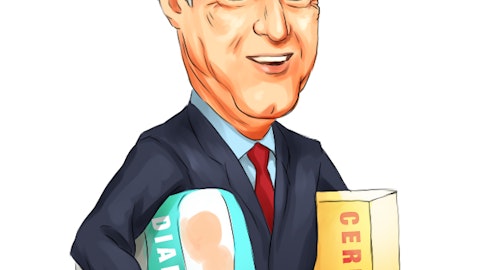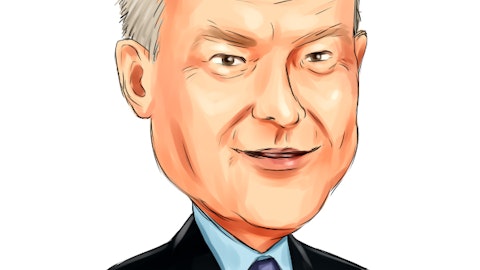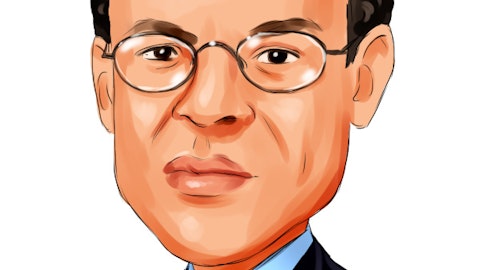Northern Trust Corporation (NASDAQ:NTRS) Q4 2022 Earnings Call Transcript January 19, 2023
Operator: Good day and welcome to the Northern Trust Corporation fourth quarter 2022 earnings conference call. Today’s conference is being recorded. At this time, I’d like to turn the conference over to Jennifer Childe. Please go ahead, ma’am.
Jennifer Childe: Thank you Marjorie. Good morning everyone and welcome to Northern Trust Corporation’s fourth quarter 2022 earnings conference call. Joining me on our call this morning are Mike O’Grady, our Chairman and CEO; Jason Tyler, our Chief Financial Officer; Lauren Allnut, our Controller, and Mark Bette, Briar Rose, and Grace Higgins from our Investor Relations team. Our fourth quarter earnings press release and financial trends report are both available on our website at northerntrust.com. Also on our website, you will find our quarterly earnings review presentation, which we will use to guide today’s conference call. This January 19 call is being webcast live on northerntrust.com. The only authorized rebroadcast of this call is the replay that will be made available on our website through February 18.
Northern Trust disclaims any continuing accuracy of the information provided in this call after today. Please refer to our Safe Harbor statement regarding forward-looking statements on Page 13 of the accompanying presentation, which will apply to our commentary on this call. During today’s question and answer session, please limit your initial query to one question and one related follow-up. This will allow us to move through the queue and enable as many people as possible the opportunity to ask questions as time permits. Thank you again for joining us today. Let me turn the call over to Mike O’Grady.

Photo by Sean Pollock on Unsplash
Michael O’Grady: Thank you Jennifer. Let me join in welcoming you to our fourth quarter 2022 earnings call. I’d like to start by thanking our teams across the company for their strong execution throughout the year in the face of significant global, political and market turmoil. It is our partners’ unwavering focus on supporting our clients in uncertain and volatile times like these that truly differentiates Northern Trust. For the full year, revenue was up 5%, including trust fee growth of 2% and our return on average common equity was 12.7%. Excluding the impact of $303 million in charges detailed in the presentation, revenue for the full year grew 8% and our return on equity was 14.9%. Fourth quarter results reflected trends that were consistent with those we saw through the first three quarters of the year, namely on a year-over-year basis weaker markets pressured our trust fees, but this was more than offset by strong increases in net interest income.
Within our wealth management business, assets under management and advisory fees grew sequentially in the fourth quarter. Total fees declined, however, due to the lag affect of markets, strategic price reductions in our index funds, and shifts in client allocations out of liquidity products. Overall, new business generation in wealth management was healthy in 2022; however, we did see some deceleration in the second half of the year as market activity waned. We continued to execute on our growth strategy in wealth management, including increasing the size and effectiveness of our sales force, expanding our digital marketing efforts, and leveraging the differentiated capabilities of the Northern Trust Institute. In asset management, assets under management were up sequentially but fees declined due to the outflows we experienced in our liquidity and indexed products as a result of the impact of both weaker markets and clients seeking alternatives.
We did see solid increases in alternative funds throughout the year, including year-over-year growth of more than 20% in the fourth quarter. Our ETF complex also continued to perform well with year-over-year organic growth of 12%. Our product launches during the year focused on ESG capabilities, including three new ESG funds in the fourth quarter. Within asset servicing, we delivered a solid finish to the year. We saw healthy momentum throughout the year with our whole office offering as investment managers are increasingly considering outsourced solutions in the face of continued margin pressure and the challenging macroeconomic environment. Whole office integrates our global asset servicing platform with innovative partners facilitating access to new technologies, services and solutions.
One recent client win offers an insight into what differentiates us in the marketplace. After an exhaustive RFP process during which we conducted a complete review of a large U.K.-based asset manager’s front to back operating model, we were selected to provide a holistic full suite of core asset servicing, capital markets and data, and analytics products and services. This client was particularly impressed with our ability to digitalize their investment process to maximize the value of their data. We learned that this client chose us because of our combination of market-leading tools and first rate client service. We also saw continued strong demand for our integrated trading solutions offering throughout both the quarter and the year. In 2022, the number of clients on the platform increased 20% year-over-year to nearly 100.
Our transition backlog that we spoke to you about last quarter started to transition in during the fourth quarter and our pipeline remains strong. Expense growth continued to be elevated in the quarter, reflecting investments in people and technology to strengthen our resiliency, advance our digital modernization efforts, and drive growth in the business, all critical initiatives but the level of growth is too high. Some of the charges we announced today reflect early steps we are taking to bring down the trajectory to better align with the current operating environment and create capacity for profitable growth. To underscore our commitment, we recently launched a dedicated office of productivity to reinforce our approach to driving efficiencies throughout the company.
Jason will provide more color on this in his prepared remarks. In closing, as we begin 2023, we remain well positioned to navigate the ongoing macroeconomic and market uncertainty from a position of strength. Our focus is on driving organic growth, improving our productivity, and continuing to bolster our foundations. I’ll now turn the call over to Jason.
See also 15 Largest Plastic Manufacturing Companies in the World and 14 Countries Where Official Language is English.
Jason Tyler: Thank you Mike, and let me join Jennifer and Mike in welcoming you to our fourth quarter 2022 earnings call. Let’s dive into the financial results of the quarter, starting on Page 2. This morning, we reported fourth quarter net income of $155.7 million. Earnings per share were $0.71 and our return on average common equity was 5.9%. Our results were unfortunately impacted by the inclusion of $266 million in pre-tax charges which reflect $199 million in net income impact and $0.94 in earnings per share impact. These charges included the following on a pre-tax basis: $213 million of investment security losses related to the intent to sell certain available for sale debt securities, which were subsequently sold in early January; $32 million of severance-related charges; $14 million of occupancy charges related to early lease exits, and $6.8 million of pension settlement charges.
Also recall that in the first quarter of this year, we implemented an accounting reclassification of certain fees which continues to impact the year-over-year comparisons, as noted on this page. Let’s move to Page 3 and review the financial highlights of the quarter. Including the charges previously mentioned, year-over-year revenue was down 8%. Expenses increased 13% and net income was down 62%. In the sequential comparison, revenue was down 13%, expenses were up 8%, while net income was down 61%. Excluding the charges previously mentioned, year-over-year revenue was up 5% and expenses increased 9%. Excluding the charges previously mentioned, on a sequential basis revenue was down 1% and expenses were up 5%. Let’s look at the results in greater detail, starting with revenue on Page 4.
Year-over-year unfavorable currency translation reduced our revenue growth by approximately 200 basis points. Trust, investment and other servicing fees representing the largest component of our revenue totaled $1 billion and were down 6% from last year and down 3% sequentially. Our trust fees continued to be unfavorably impacted by the weaker equity and fixed income markets and unfavorable currency movements. As a reminder, a significant portion of our trust fees are recorded on a month or quarter lag basis, so this quarter’s performance is largely reflective of the third quarter’s market performance as well as the months of October and November. The year-over-year and sequential declines in all other remaining non-interest income are primarily driven by the $213 million pre-tax investment security loss due to the intent to sell certain available for sale debt securities.
These securities were subsequently sold in early January 2023, which I’ll describe in more detail in a few minutes. Net interest income on an FTE basis, which I’ll also discuss in more detail later, was $550 million and was up 48% from a year ago and up 5% sequentially. Let’s look at the components of our trust and investment fees on Page 5. For our asset servicing business, fees totaled $588 million and were down 6% year-over-year and down 3% sequentially. Within asset servicing, custody and fund administration fees were $406 million, down 11% year-over-year but importantly they were flat sequentially. Custody and fund administration fees decreased from the prior year quarter primarily due to unfavorable markets and unfavorable currency translations, partially offset by new business.
Assets under custody and administration for asset servicing clients were $13 trillion at quarter end, down 16% year-over-year and up 6% sequentially. The year-over-year decline was primarily driven by unfavorable markets and currency translation. The sequential increase was primarily driven by favorable markets and currency translation. Investment management fees within asset servicing were $124 million, up 9% year-over-year and down 9% sequentially. Investment management fees decreased sequentially primarily due to asset outflows and unfavorable markets. Investment management fees increased from the prior year quarter primarily due to lower money market fund fee waivers partially offset by asset outflows and unfavorable markets. Assets under management for asset servicing clients were $898 billion, down 25% year-over-year and up 3% sequentially.
The year-over-year decline was driven by asset outflows, weaker equity and fixed income markets, and unfavorable currency translation. The sequential growth was driven by favorable markets and currency translation partially offset by asset outflows. Moving to our wealth management business, trust, investment and other servicing fees were $454 million, down 7% compared to the prior year and down 5% from the prior quarter. Within the regions, the year-over-year declines were primarily driven by unfavorable market impacts and asset outflows partially offset by the elimination of money market fund fee waivers. Sequentially the decline within the regions was primarily driven by unfavorable markets, asset outflows, and a strategic re-pricing initiative.
With global family office, the year-over-year growth was driven by lower fee waivers and new business, partially offset by unfavorable markets. The sequential decrease was mainly related to asset outflows, unfavorable markets, and the re-pricing initiative. Assets under management for our wealth management clients were $351 billion at quarter end, down 16% year-over-year and up 5% on a sequential basis. The year-over-year decline was driven by primarily by unfavorable markets and asset outflows. The sequential increase was primarily due to favorable markets. Moving to Page 6, net interest income was $550 million in the quarter and was up 48% from the prior year. Earnings assets averaged $134 billion in the quarter, down 10% versus the prior year.
Average deposits were $116 billion and were down 14% versus the prior year, while loan balances averaged $42 billion, up 6% compared to the prior year. On a sequential quarter basis, net interest income grew 5%. Average earnings assets were up 1%. Average deposits declined 2% while average loan balances were up 2%. The net interest margin was 1.63% in the quarter, up 64 basis points from a year ago and up 5 basis points from the prior quarter. The prior year quarter increase is primarily due to higher average interest rates. The sequential increase is primarily due to higher average interest rates partially offset by an unfavorable balance sheet mix. Turning to Page 7, on a year-over-year basis expense growth benefited by approximately 300 basis points due to currency translation.
As reported, expenses were $1.3 billion in the fourth quarter, 13% higher than the prior year and 8% higher than the prior quarter. The current quarter’s expenses included $53 million in charges. These charges in part reflect steps we’re taking in conjunction with the launch of our office of productivity. To shift away, we approach and manage our expenses. Through this initiative, we expect to leverage data and analytics to help us better understand the efficacy of our spending so as to optimize our cost base and drive greater efficiencies throughout the organization. We’ll update you on our progress in the coming quarters as appropriate. Excluding charges in both periods, expenses in the fourth quarter were up 10% year-over-year and up 5% sequentially.
Also, recall that the current quarter includes the impact of the previously mentioned accounting reclassification, which increased other operating expense by $8.6 million compared to the prior year. Compensation expense was up 15% compared to the prior year and up 6% sequentially. The year-over-year growth was primarily driven by higher salary expense in part due to inflationary pressures, and the previously mentioned severance-related charges partially offset by favorable currency translation. The sequential increase is primarily due to the aforementioned severance-related charges and higher salary expense, partially offset by lower incentives. Employee benefits expense was down 4% compared to the prior quarter and down 6% sequentially. The year-over-year decrease was primarily driven by lower ongoing pension expense partially offset by higher medical costs.
The sequential decrease was primarily due to lower pension costs, including the lower pension settlement charge relative to the prior period partially offset by higher medical costs. Outside services expense was $233 million and was up 4% from a year ago and up 5% sequentially. The year-over-year increase was primarily driven by higher technical services costs, legal services and consulting services, partially offset by lower third party advisory fees and sub-custodian expense. The sequential increase was primarily due to higher technical services costs and legal services, partially offset by lower sub-custodian expense and consulting costs. Equipment and software expense of $229 million was up 17% from a year ago and up 8% sequentially. The year-over-year and sequential growth are both primarily driven by higher software costs due to continued investments in technology as well as inflationary pressures, and higher amortization.
We also recognized a $3.8 million termination charge associated with our mainframe strategy. Occupancy expense of $66 million was up 27% from a year ago and up 28% sequentially. The year-over-year and sequential growth were both primarily driven by the previously mentioned $14 million of charges related to early lease exits. Other operating expense of $108 million was up 37% from a year ago and up 31% sequentially. The year-over-year increase was primarily driven by higher staff-related expense, business promotion, and miscellaneous expense. The sequential increase is primarily due to higher business promotion, supplemental compensation plan expense, and miscellaneous expenses in the current period. Turning to the full year, our results in 2022 are summarized on Page 8.
On the right margin of this page, we outline the charges that we called out for both years. Included in these items, net income was $1.3 billion, down 14% compared to 2021, and earnings per share were $6.14, down 14% from the prior year. In 2022, these charges had a $227 million impact on net income and a $1.08 impact on earnings per share. In 2021, these charges had an $18 million impact on net income and a $0.07 impact on earnings per share. Full year revenue and expense trends are outlined on Page 9 and include the charges previously mentioned. Trust, investment and other servicing fees grew 2% in 2022. The growth during the year was primarily driven by lower money market fee waivers and new business, partially offset by unfavorable markets and unfavorable currency translation.
Net interest income grew 36%. Average earnings assets during the year decreased by 10% while the net interest margin increased 64 basis points, driven by higher average interest rates. The net result was revenue growth of 5% in 2022 compared to 2021 and expense growth of 10%. Excluding these charges in both periods, revenue for the full year was up 8% from the prior year and expenses were up 9%. Turning to Page 10, our capital ratios remain strong with our common equity Tier 1 ratio of 10.8% under the standardized approach, up from the prior quarter’s 10.1%. Our Tier 1 leverage ratio was 7.1%, up from 7% in the prior quarter. A decrease in net unrealized losses in the available for sale securities portfolio and less foreign exchange volatility were the primary factors in this quarter’s increase in capital ratios.
Accumulated other comprehensive income at the end of the quarter was a loss of $1.6 billion. During the quarter, we returned $158.9 million to common shareholders through cash dividends of $158.8 million and share repurchases of $0.1 million. In early January of this year, we sold $2.1 billion of higher capital consuming, lower yielding, non-HQLA debt securities and reinvested the proceeds into lower capital consuming, higher yielding HQLA assets. This repositioning offered the unique opportunity to de-risk our portfolio, free up capital, and improve our liquidity ratios while simultaneously generating more attractive returns. With that, Marjorie, please open the lines for questions.
Q&A Session
Follow Northern Trust Corp (NASDAQ:NTRS)
Follow Northern Trust Corp (NASDAQ:NTRS)
Operator: Thank you very much. We’ll pause for a moment to allow the opportunity to signal for questions, but while we do, we’ll take our first question from Glenn Schorr from Evercore. Please go ahead.
Jason Tyler: Good morning Glenn.
Glenn Schorr: Good morning. I guess I’ll try and focus on deposits. So the interest bearing down 12%, the non-interest bearing down 48% year-on-year, but there’s a clear declining impact on a sequential basis, so I’m curious, a much higher rate paid and a decelerating outflow of deposits, how can you help us think through what to expect in 2023 on both attrition, mix and betas for deposits? Thank you.
Jason Tyler: Sure, well let me–you know, there’s a lot going on with the balance sheet, with the repositioning as well, so let me give you a couple of the key ingredients and then let me know if there’s additional detail you’d like. Just on volume, we saw volume up–down left to 116. We still think that that 110 to 115 is a good starting point for first quarter, and as you know, the quarters have some seasonality. We usually get a spike at the end of fourth quarter, first quarter gets some build from tax preparation, and in the second quarter we’ll start to see outflows as clients pay taxes. But as you think about first quarter at least, 110 to 115 is still a good range. Then let me take beta in three different–or rates, really, in three different parts.
First beta, and you noted that beta was high. We’d indicated we thought it would be at this point in the cycle, and we still think that that’s a pretty good indication of what we’ll look like over the course of the next three months. Beta for interest-bearing deposits was 75%, 80%, it was in line. We do anticipate that to be similar. Balance sheet repositioning, that takes $2 billion, a little bit more at what was about 2% or 2.25%, then it reinvests it on the short end of the curve a couple hundred basis points higher. Right now, we’re mostly overnight, but we’ll continue to think about what we want to do with that from a non-HQLA perspective. But at least the starting point you should be thinking about is moving that $2 billion to overnight.
Then just lastly as we’re talking about rate, just a quick reminder the runoff on the portfolio is just over a billion dollars, and you’re moving that from 2%, 2.25% to higher rates we’re repositioning as we mature securities to the short end, so there’s a similar pickup there. Then last thing on outlook, just as you think about first quarter, just remember that day count costs us about $8 million going from fourth quarter to first quarter. Those are the big ingredients. Hopefully that’s helpful.
Glenn Schorr: Wow, that’s well prepared. Thank you. Appreciate it. Maybe just a follow-up, a similar question on average earning assets up 1% quarter-on-quarter. Should we feel in the range of stable now, or I guess–
Jason Tyler: Yes, it’s hard to tell. I mean, I think about it very much from–obviously, as you know, it’s a liability-driven balance sheet, and so the common carry on deposits is really what’s driving the size of average earning assets in general. What we saw in the quarter, it certainly does look like things have–like client behavior has settled and leveled out a little bit, but we’re not calling it flat at this point. We’re still operating in a way that we’re anticipating some muted but continued decline. That’s why that 110 to 115, that’s really the drive–you should think of that as the driver of average earning assets.
Glenn Schorr: Okay, I appreciate all that. Thanks.
Jason Tyler: Sure.
Operator: Thank you. We’ll take our next question from Betsy Graseck from Morgan Stanley. Please go ahead.




